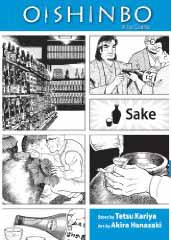I liked the first volume of Oishinbo (Viz) very much. I flat-out loved the second, and I think this is only partly because it’s focused on booze.
 Anyway, for those of you who aren’t familiar with the series, it’s a sort of “best of” sampler of a long-running, much-loved culinary manga. Viz is publishing the A la Carte collections, which focus on a particular aspect of cuisine. In this case, it’s sake and some lesser beverages, like champagne.
Anyway, for those of you who aren’t familiar with the series, it’s a sort of “best of” sampler of a long-running, much-loved culinary manga. Viz is publishing the A la Carte collections, which focus on a particular aspect of cuisine. In this case, it’s sake and some lesser beverages, like champagne.
Many have noted what we might call the “hometown pride” of these stories, written by Tetsu Kariya and illustrated Akira Hanasaki. I don’t really find it problematic; I sort of expect a culture to favor its indigenous cuisine. And since Kariya reserves most of his teasing for the French, who are no slouches in the culinary pride arena themselves, it reads more to me like entertaining trash talking than anything more sinister. (I kind of wish there was a bande-dessinée response. “Oh, non, vous n’avez fait!”)
On the beverage front, Kariya seems to have a grand time smacking around the drops of god. Champagne is perfectly lovely, intrepid food journalist Yamaoka insists, unless you try and eat anything with it. Beaujolais nouveau is little more than a French prank that the Japanese have fallen for hook, line and sinker. After such flat dismissals of another culture’s beverages of choice, you’d expect sake to be swaddled in adoration, right?
Well, no, and that’s when the volume goes from amusingly snarky to downright fascinating. Yamaoka is trying to convince a co-worker of the virtues of sake, which she dismisses as booze for old men, by taking her to a small, local brewery. Sake, he insists, can be transcendent if it’s made properly. Unfortunately, profit-mongering corporations and nonexistent oversight have lined the nation’s liquor up for every manner of abuse. Alas, the small, local brewery is about to be forced to make the same kind of grocery-store swill Yamaoka abhors, unless our heroes can help the owners secure a loan.
Can the local brewery be saved from ruthless corporate forces? More importantly, can sake as it was meant to be be saved from those same forces? Never fear, for the foodie-journalist equivalent of Mystery, Inc. is on the case! They don’t quite put on a show in someone’s barn to save Japan’s national beverage, but they come hilariously close in the multi-chapter story that follows. The heightened charms of the story aside, it has really interesting things to say about the importance of preserving cultural traditions and looking to dedicated, artisanal producers to do that. It’s even reasonably fair to the money men who have their eyes fixed on the bottom line.
As someone who keeps at least one eye on the resurgence of locally grown, sustainably produced foods and the associated embrace of food quality, this volume really struck a nice chord with me. While 90% of the Food Network’s programming seems to be reaching for the can opener and dumbing down everything Julia Child hoped popular culinary education could be, it’s nice to pick up a comic that cares so passionately about food and the way it’s made.
